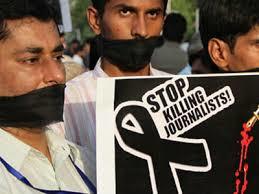
The massacre of journalists continues unabated. Probably, 2016 will be remembered as one of the bloodiest years of the last two decades. But it is very hard to gauge how many actually have lost their lives while they were engaged in spreading information of public interest, and thus exercising a fundamental right
Link: Ossigeno per l'informazione
The organizations that keep track of these victims provide dramatic, but divergent, statements. They range from 101 victims (one every three days) reported by UNESCO (read more ), the 93 listed by the International Federation of Journalists, the 74 recorded by Reporters Sans Frontieres, to 80, “Death Watch” by the International Press Institute in Vienna, 48 to the Committee to Protect Journalists in New York, which signals the episodes that are confirmed to the same organization.
They are all very institutions series and, among other things, cooperate with each other. No coincidence that these figures are summarized in the newsletter of “United Nation Plan of action on the safety of journalists and the issue of impunity” by UNESCO widespread laws. (read )
This discrepancy appears inexplicable. And there should not be one for it defeats the aim of giving strength, effectiveness, and impact to the alarm capability needed to spread these kinds of data, to create the necessary attention on this carnage and the poor state of health of freedom of information in the world of today, the absence of adequate protections for journalists and other professionals and adequate and concrete measures to overcome this tragic situation.
When we launch these alarms, when we make statements of facts so serious, when we draw the attention of governments on them, we have to speak with absolute precision, to show those who strive not to see these facts that large organizations, at least, can agree between them. The data that provide the dimensions of the most serious violations of freedom of information are extremely powerful for they have a great impact on the decisions and on guiding the public opinion. But they must be consistent. Its strange that they still aren’t, and it is sad that there is no public debate yet, no information on what is being done to provide a shared balance, as if the problem weren’t even there.
This discrepancy is also noticeable on the number and location of the threatened journalists and those imprisoned and says that there is a confusion of voices.
While facing this holocaust, the almost absolute impunity of those who commit these crimes, the inertia of government authorities, the increasingly dramatic appeals to do something multiply, but fall on deaf ears.
Maybe things will change when we can describe these phenomena uniformly. At the end of the nineteenth century the modern world, to promote trade, took a big step forward by creating the International System of weights and measures. We must do something analogous to defend violations of press freedom.
This publication has been produced within the project European Centre for Press and Media Freedom, co-funded by the European Commission. The contents of this publication are the sole responsibility of Osservatorio Balcani e Caucaso and its partners and can in no way be taken to reflect the views of the European Union. The project's page

 2016 annus horribilis. Beaten the record of number of journalists killed
2016 annus horribilis. Beaten the record of number of journalists killed




 All the contents on the Osservatorio Balcani e Caucaso website are distributed with a
All the contents on the Osservatorio Balcani e Caucaso website are distributed with a 